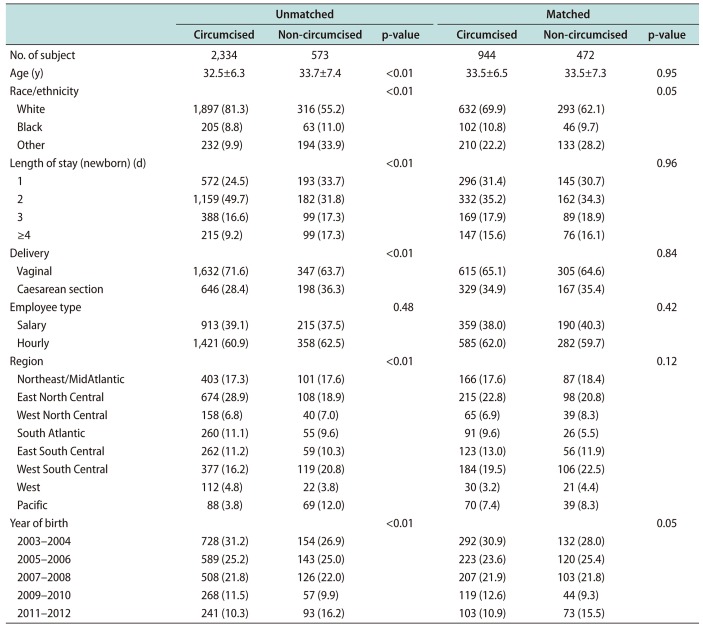1. American Academy of Pediatrics Task Force on Circumcision. Male circumcision. Pediatrics. 2012; 130:e756–e785. PMID:
22926175.
2. Sorokan ST, Finlay JC, Jefferies AL. Canadian Paediatric Society, Fetus and Newborn Committee, Infectious Diseases and Immunization Committee. Newborn male circumcision. Paediatr Child Health. 2015; 20:311–320. PMID:
26435672.

3. Morris BJ, Klausner JD, Krieger JN, Willcox BJ, Crouse PD, Pollock N. Canadian Pediatrics Society position statement on newborn circumcision: a risk-benefit analysis revisited. Can J Urol. 2016; 23:8495–8502. PMID:
27705739.
4. Morris BJ, Kennedy SE, Wodak AD, Mindel A, Golovsky D, Schrieber L, et al. Early infant male circumcision: systematic review, risk-benefit analysis, and progress in policy. World J Clin Pediatr. 2017; 6:89–102. PMID:
28224100.

5. Centers for Disease Control and Preventation (CDC). Recommendations for providers counseling male patients and parents regarding male circumcision and the prevention of HIV infection, STIs, and other health outcomes. Atranta (GA): CDC;2014.
6. Schoen EJ, Colby CJ, Ray GT. Newborn circumcision decreases incidence and costs of urinary tract infections during the first year of life. Pediatrics. 2000; 105:789–793. PMID:
10742321.

7. To T, Agha M, Dick PT, Feldman W. Cohort study on circumcision of newborn boys and subsequent risk of urinary-tract infection. Lancet. 1998; 352:1813–1816. PMID:
9851381.

8. Smellie JM, Prescod NP, Shaw PJ, Risdon RA, Bryant TN. Childhood reflux and urinary infection: a follow-up of 10-41 years in 226 adults. Pediatr Nephrol. 1998; 12:727–736. PMID:
9874316.

9. Goonasekera CD, Dillon MJ. Hypertension in reflux nephropathy. BJU Int. 1999; 83(Suppl 3):1–12.

10. Hellerstein S. Long-term consequences of urinary tract infections. Curr Opin Pediatr. 2000; 12:125–128. PMID:
10763761.

11. Jacobson SH, Eklöf O, Eriksson CG, Lins LE, Tidgren B, Winberg J. Development of hypertension and uraemia after pyelonephritis in childhood: 27 year follow up. BMJ. 1989; 299:703–706. PMID:
2508881.

12. El Bcheraoui C, Zhang X, Cooper CS, Rose CE, Kilmarx PH, Chen RT. Rates of adverse events associated with male circumcision in U.S. medical settings, 2001 to 2010. JAMA Pediatr. 2014; 168:625–634. PMID:
24820907.

13. Centers for Disease Control and Preventation (CDC). Recommendations for providers counseling male patients and parents regarding male circumcision and the prevention of HIV infection, STIs, and other health outcomes. Docket Number CDC-2014-0012. Atranta (GA): CDC;2014.
14. Morris BJ, Wiswell TE. Circumcision and lifetime risk of urinary tract infection: a systematic review and meta-analysis. J Urol. 2013; 189:2118–2124. PMID:
23201382.

15. Jagannath VA, Fedorowicz Z, Sud V, Verma AK, Hajebrahimi S. Routine neonatal circumcision for the prevention of urinary tract infections in infancy. Cochrane Database Syst Rev. 2012; 11:CD009129. PMID:
23152269.

16. Introcaso CE, Xu F, Kilmarx PH, Zaidi A, Markowitz LE. Prevalence of circumcision among men and boys aged 14 to 59 years in the United States, National Health and Nutrition Examination Surveys 2005-2010. Sex Transm Dis. 2013; 40:521–525. PMID:
23965763.

17. Clougherty JE, Eisen EA, Slade MD, Kawachi I, Cullen MR. Workplace status and risk of hypertension among hourly and salaried aluminum manufacturing employees. Soc Sci Med. 2009; 68:304–313. PMID:
19027215.

18. Sakr CJ, Taiwo OA, Galusha DH, Slade MD, Fiellin MG, Bayer F, et al. Reproductive outcomes among male and female workers at an aluminum smelter. J Occup Environ Med. 2010; 52:137–143. PMID:
20134342.

19. Kubo J, Goldstein BA, Cantley LF, Tessier-Sherman B, Galusha D, Slade MD, et al. Contribution of health status and prevalent chronic disease to individual risk for workplace injury in the manufacturing environment. Occup Environ Med. 2014; 71:159–166. PMID:
24142977.

20. Cullen MR, Checkoway H, Alexander BH. Investigation of a cluster of pituitary adenomas in workers in the aluminum industry. Occup Environ Med. 1996; 53:782–786. PMID:
9038804.

21. Cullen MR, Vegso S, Cantley L, Galusha D, Rabinowitz P, Taiwo O, et al. Use of medical insurance claims data for occupational health research. J Occup Environ Med. 2006; 48:1054–1061. PMID:
17033505.

22. Pollack KM, Agnew J, Slade MD, Cantley L, Taiwo O, Vegso S, et al. Use of employer administrative databases to identify systematic causes of injury in aluminum manufacturing. Am J Ind Med. 2007; 50:676–686. PMID:
17676586.

23. Rabinowitz PM, Galusha D, Slade MD, Dixon-Ernst C, O'Neill A, Fiellin M, et al. Organic solvent exposure and hearing loss in a cohort of aluminium workers. Occup Environ Med. 2008; 65:230–235. PMID:
17567727.

24. Wiswell TE, Enzenauer RW, Holton ME, Cornish JD, Hankins CT. Declining frequency of circumcision: implications for changes in the absolute incidence and male to female sex ratio of urinary tract infections in early infancy. Pediatrics. 1987; 79:338–342. PMID:
3822633.

25. D'Agostino RB Jr. Propensity score methods for bias reduction in the comparison of a treatment to a non-randomized control group. Stat Med. 1998; 17:2265–2281. PMID:
9802183.
26. Braitman LE, Rosenbaum PR. Rare outcomes, common treatments: analytic strategies using propensity scores. Ann Intern Med. 2002; 137:693–695. PMID:
12379071.

27. Hallett RJ, Pead L, Maskell R. Urinary infection in boys.A three-year prospective study. Lancet. 1976; 2:1107–1110. PMID:
62948.
28. Shaikh N, Morone NE, Bost JE, Farrell MH. Prevalence of urinary tract infection in childhood: a meta-analysis. Pediatr Infect Dis J. 2008; 27:302–308. PMID:
18316994.
29. Lewis EN, Griffin MR, Szilagyi PG, Zhu Y, Edwards KM, Poehling KA. Childhood influenza: number needed to vaccinate to prevent 1 hospitalization or outpatient visit. Pediatrics. 2007; 120:467–472. PMID:
17766517.








 PDF
PDF ePub
ePub Citation
Citation Print
Print



 XML Download
XML Download